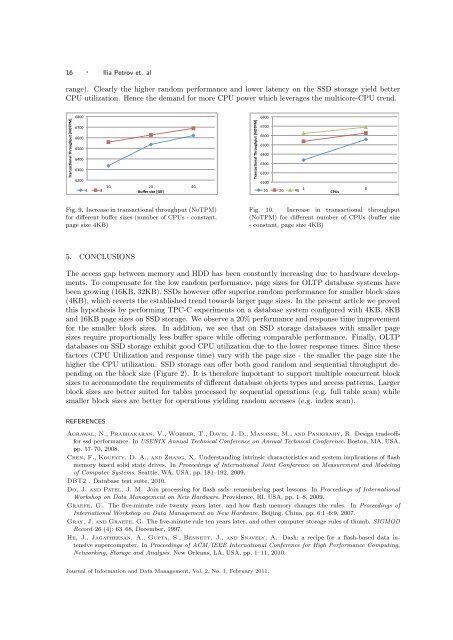Page Size Selection for OLTP Databases on SSD RAID Storage
Page Size Selection for OLTP Databases on SSD RAID Storage
Page Size Selection for OLTP Databases on SSD RAID Storage
You also want an ePaper? Increase the reach of your titles
YUMPU automatically turns print PDFs into web optimized ePapers that Google loves.
16 · Ilia Petrov et. al<br />
range). Clearly the higher random per<str<strong>on</strong>g>for</str<strong>on</strong>g>mance and lower latency <strong>on</strong> the <strong>SSD</strong> storage yield better<br />
CPU utilizati<strong>on</strong>. Hence the demand <str<strong>on</strong>g>for</str<strong>on</strong>g> more CPU power which leverages the multicore-CPU trend.<br />
Transac'<strong>on</strong>al Throughput [NOTPM] <br />
6800 <br />
6700 <br />
6600 <br />
6500 <br />
6400 <br />
6300 <br />
6200 <br />
1G 2G 4G <br />
4 8 <br />
Buffer size [GB] <br />
Fig. 9. Increase in transacti<strong>on</strong>al throughput (NoTPM)<br />
<str<strong>on</strong>g>for</str<strong>on</strong>g> different buffer sizes (number of CPUs - c<strong>on</strong>stant,<br />
page size 4KB)<br />
5. CONCLUSIONS<br />
Transac'<strong>on</strong>al Throughput [NOTPM] <br />
6800 <br />
6700 <br />
6600 <br />
6500 <br />
6400 <br />
6300 <br />
6200 <br />
6100 <br />
1G 2G 4G <br />
4 8 <br />
CPUs <br />
Fig. 10. Increase in transacti<strong>on</strong>al throughput<br />
(NoTPM) <str<strong>on</strong>g>for</str<strong>on</strong>g> different number of CPUs (buffer size<br />
- c<strong>on</strong>stant, page size 4KB)<br />
The access gap between memory and HDD has been c<strong>on</strong>stantly increasing due to hardware developments.<br />
To compensate <str<strong>on</strong>g>for</str<strong>on</strong>g> the low random per<str<strong>on</strong>g>for</str<strong>on</strong>g>mance, page sizes <str<strong>on</strong>g>for</str<strong>on</strong>g> <str<strong>on</strong>g>OLTP</str<strong>on</strong>g> database systems have<br />
been growing (16KB, 32KB). <strong>SSD</strong>s however offer superior random per<str<strong>on</strong>g>for</str<strong>on</strong>g>mance <str<strong>on</strong>g>for</str<strong>on</strong>g> smaller block sizes<br />
(4KB), which reverts the established trend towards larger page sizes. In the present article we proved<br />
this hypothesis by per<str<strong>on</strong>g>for</str<strong>on</strong>g>ming TPC-C experiments <strong>on</strong> a database system c<strong>on</strong>figured with 4KB, 8KB<br />
and 16KB page sizes <strong>on</strong> <strong>SSD</strong> storage. We observe a 20% per<str<strong>on</strong>g>for</str<strong>on</strong>g>mance and resp<strong>on</strong>se time improvement<br />
<str<strong>on</strong>g>for</str<strong>on</strong>g> the smaller block sizes. In additi<strong>on</strong>, we see that <strong>on</strong> <strong>SSD</strong> storage databases with smaller page<br />
sizes require proporti<strong>on</strong>ally less buffer space while offering comparable per<str<strong>on</strong>g>for</str<strong>on</strong>g>mance. Finally, <str<strong>on</strong>g>OLTP</str<strong>on</strong>g><br />
databases <strong>on</strong> <strong>SSD</strong> storage exhibit good CPU utilizati<strong>on</strong> due to the lower resp<strong>on</strong>se times. Since these<br />
factors (CPU Utilizati<strong>on</strong> and resp<strong>on</strong>se time) vary with the page size - the smaller the page size the<br />
higher the CPU utilizati<strong>on</strong>. <strong>SSD</strong> storage can offer both good random and sequential throughput depending<br />
<strong>on</strong> the block size (Figure 2). It is there<str<strong>on</strong>g>for</str<strong>on</strong>g>e important to support multiple c<strong>on</strong>current block<br />
sizes to accommodate the requirements of different database objects types and access patterns. Larger<br />
block sizes are better suited <str<strong>on</strong>g>for</str<strong>on</strong>g> tables processed by sequential operati<strong>on</strong>s (e.g. full table scan) while<br />
smaller block sizes are better <str<strong>on</strong>g>for</str<strong>on</strong>g> operati<strong>on</strong>s yielding random accesses (e.g. index scan).<br />
REFERENCES<br />
Agrawal, N., Prabhakaran, V., Wobber, T., Davis, J. D., Manasse, M., and Panigrahy, R. Design tradeoffs<br />
<str<strong>on</strong>g>for</str<strong>on</strong>g> ssd per<str<strong>on</strong>g>for</str<strong>on</strong>g>mance. In USENIX Annual Technical C<strong>on</strong>ference <strong>on</strong> Annual Technical C<strong>on</strong>ference. Bost<strong>on</strong>, MA, USA,<br />
pp. 57–70, 2008.<br />
Chen, F., Koufaty, D. A., and Zhang, X. Understanding intrinsic characteristics and system implicati<strong>on</strong>s of flash<br />
memory based solid state drives. In Proceedings of Internati<strong>on</strong>al Joint C<strong>on</strong>ference <strong>on</strong> Measurement and Modeling<br />
of Computer Systems. Seattle, WA, USA, pp. 181–192, 2009.<br />
DBT2 . Database test suite, 2010.<br />
Do, J. and Patel, J. M. Join processing <str<strong>on</strong>g>for</str<strong>on</strong>g> flash ssds: remembering past less<strong>on</strong>s. In Proceedings of Internati<strong>on</strong>al<br />
Workshop <strong>on</strong> Data Management <strong>on</strong> New Hardware. Providence, RI, USA, pp. 1–8, 2009.<br />
Graefe, G. The five-minute rule twenty years later, and how flash memory changes the rules. In Proceedings of<br />
Internati<strong>on</strong>al Workshop <strong>on</strong> Data Management <strong>on</strong> New Hardware. Beijing, China, pp. 6:1–6:9, 2007.<br />
Gray, J. and Graefe, G. The five-minute rule ten years later, and other computer storage rules of thumb. SIGMOD<br />
Record 26 (4): 63–68, December, 1997.<br />
He, J., Jagatheesan, A., Gupta, S., Bennett, J., and Snavely, A. Dash: a recipe <str<strong>on</strong>g>for</str<strong>on</strong>g> a flash-based data intensive<br />
supercomputer. In Proceedings of ACM/IEEE Internati<strong>on</strong>al C<strong>on</strong>ference <str<strong>on</strong>g>for</str<strong>on</strong>g> High Per<str<strong>on</strong>g>for</str<strong>on</strong>g>mance Computing,<br />
Networking, <strong>Storage</strong> and Analysis. New Orleans, LA, USA, pp. 1–11, 2010.<br />
Journal of In<str<strong>on</strong>g>for</str<strong>on</strong>g>mati<strong>on</strong> and Data Management, Vol. 2, No. 1, February 2011.















